In Russia, more than 30,000 people die every year due to car accidents, and almost ten times more people get injuries of varying degrees. Such sad statistics could be less if the people around could help the victims in time, because in almost 80% of cases, deaths could have been avoided. In this case, timely first aid in case of an accident would help.
Often death occurs not from injuries that are incompatible with life, but due to inept or incorrect actions performed to resuscitate the victims. Also, the fault of the tragedies is the inaction of the participants in the events, who do not know how to help the drivers and passengers involved in the accident.
Drivers who are involved in traffic accidents and do not provide assistance to the victims may be prosecuted. These norms are directly spelled out in the Criminal Code of the Russian Federation, Chapter 16, Article 124 and Article 125 as amended in 2016.
According to the rules traffic drivers in case of an accident are required to provide first aid to the victims. If this does not happen, then they may subsequently be subject to criminal sanctions, which also provide for financial punishment, corrective labor or imprisonment.
Most common car accident injuries
A common injury during an accident is fractures or other bone injuries. In more rare cases, dislocations occur. Muscle injuries are also infrequent cases of damage to the body. This is accompanied by bleeding, which disrupts the performance of muscle tissue. In addition to hemorrhages, muscle strains appear.
During significant blood loss, blood pressure drops, and the victim, who will not be provided with the first medical care in an accident, may die. His heart will stop. Cardiac arrest will also occur during a sharp blow to the chest area, and with the same impact on the left side, the integrity of the spleen is violated.

Dangerous are stab wounds in the pleural cavity. With such an impact, the ribs break at the same time, the patient gets chest bruises, the lungs can be damaged.
Mandatory actions at the scene of the accident
When an accident occurs, it is necessary to quickly indicate its place using the sign " Emergency stop» and included light signal"Emergency". In this way, you can secure the accident area.
Any, including the first aid in case of an accident, should be provided in such a way as not to create a threat to those who help. After all, in a collision with poles of electrical wires, some sections may be energized. Or the fire that has started spreads to the gas tank.
Need to know what petrol cars burn out in five minutes.
All actions should be performed, albeit quickly, but thoughtfully. Urgent need to call ambulance. The operator will need to provide current information about the victims:
- the number of people in need of medical care;
- approximate age group affected (child, elderly, middle-aged, etc.);
- explain the general situation with the victims (bleeding, fractures, unconsciousness);
- give the most accurate address (indicate the nearest noticeable landmarks);
- leave your details and phone number (it is possible to clarify the route for the ambulance).

If the victims road accident participants blocked due to an accident by a car or in another way that you cannot handle on your own, then you need to call the Ministry of Emergencies. When an early extraction is required, it is worth doing it very carefully so as not to aggravate the situation.
Identification of the victim's condition
Before the ambulance arrives, you need to find out the patient's condition by asking a couple of questions to identify the localization of pain. Psychological support is also important. At this moment, two stages of shock may appear: in the first case, there will be an unawareness of the situation and severity, in the second stage, the shock develops, developing into a depressed state. Then fainting may occur.
Loss of consciousness is accompanied by rolling of the eyes, blanching of the skin, the steady state of the body is lost. Attacks can last 1-2 minutes with periodic recovery of consciousness.
If possible, it is necessary to lay such a victim on his back, free his throat from fastened collars, give more air. The first aid kit should contain a bottle of ammonia. Having moistened cotton wool or any fabric in this liquid, it is necessary to periodically bring it to the face of the victim.
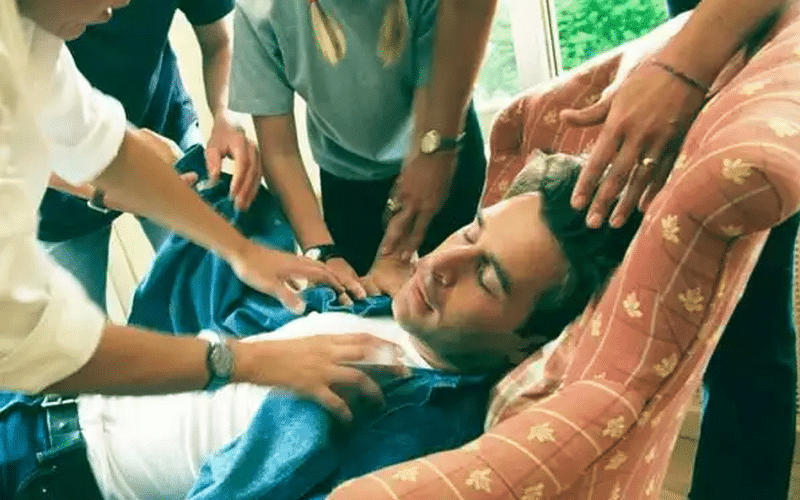
When the victim does not show signs of life, excluding obvious death, it is necessary to apply rehabilitation actions to him. The main signs by which it is revealed whether a person is alive consist of the following items:
- a clear or weak heartbeat, which can be determined by touching the left chest area with your hand;
- the presence of a clear or filiform pulse, which is determined on the carotid artery in the neck, on the temples or on the inner bend of the elbow or hand;
- the presence of breathing can be detected even with a slight raising / lowering of the chest, using a mirror brought to the mouth or nose (it will fog up from breathing), as well as from the swaying of cotton wool, which is also located in the area of the nose or mouth;
- shining a flashlight into the eye, the pupil should respond by narrowing.
You need to know that during deep syncope, the pupil may practically not respond to stimuli.
If there is no flashlight at hand, then you can close your eye with your palm and quickly open it to see the reaction of the pupil. The presence of any of these signs should be a reason for independent resuscitation and life saving.
Help with coma
Loss of consciousness, in which a cerebral coma can occur, is usually accompanied by a state similar to deep sleep. The pulse will be heard, and when exhaling, obvious hoarse sounds are felt. The tongue may stick to the upper inner wall of the mouth.
Such a victim can be shifted carefully on his side or on his stomach, while ensuring sufficient patency for breathing. To clean your mouth from possible blockage, you can use a clean handkerchief or other piece of cloth. If the functions of breathing and heartbeat are violated, then resuscitation should be started immediately.
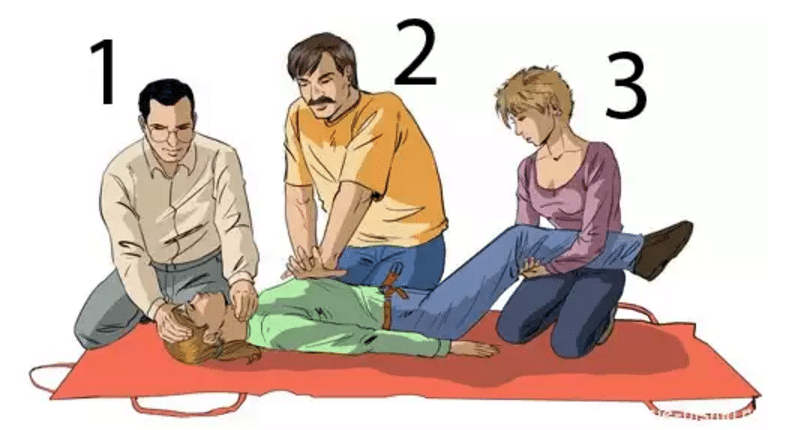
Artificial respiration
Artificial respiration should be started only if there is no natural respiration.
The victim has only 8-10 minutes to return to life without resuscitation, otherwise irreversible processes will occur. Therefore, it is necessary to save lives immediately.
The mouth is cleared of possible blood or other fluids. Align the chin in line with the neck. A handkerchief or a bandage folded several times is put on the mouth. Having taken in more air, we exhale it into the mouth of the victim for 1 second, while at the same time pinching his nose. We do the procedure three times with a two-second delay.

We control the appearance of a pulse in the carotid artery. If not, then you need to perform an indirect heart massage. For every 15 chest thrusts, 2 breaths are taken into the victim's mouth. Usually after 2-3 minutes there are signs of life.
Help with bleeding
Consider how to provide first aid for an injury resulting from an accident. Such wounds can be chopped, stab, lacerated, etc. In this case, the process is often accompanied by bleeding, sometimes internal, sometimes external. The skin turns pale, weakness increases, loss of consciousness is possible.
There are three types of bleeding:
- arterial– scarlet fountains of blood are pushed out by a pulsating method, is the most dangerous view because blood flows from the heart;
- venous- dark red blood continuously flows from the wound;
- capillary- blood comes from the entire surface of the injury.
It is necessary to block the course of arterial bleeding with the help of a tourniquet, which is applied 2-3 cm above the blood flow over clothing. If this is not done, then the loss of about one and a half liters of blood to an adult threatens death.
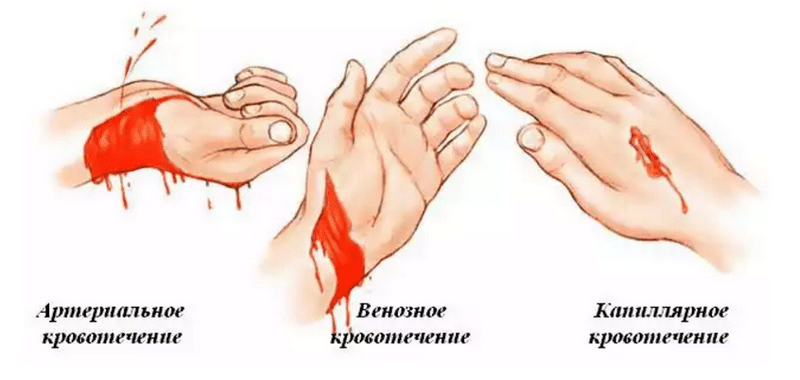
A note must be attached to the tourniquet with the time of application, since it must be removed in winter in half an hour, and in the warm season no later than an hour. After giving 4-5 minutes to restore the blood supply, you can again clamp the blood flow.
In case of head injuries, the infection is prevented from penetrating into the wound by covering the area with a sterile bandage, cotton wool is placed on top and bandaged.
Damage to the abdominal cavity is filled back, and outside is fixed with a bag using adhesive tape. With closed injuries of the peritoneum, you need to lie on your side and bend your knees. If possible, cold is applied to the affected area for 15-20 minutes.
During bruises, tight bandages are applied to eliminate or reduce internal bleeding. In such cases, fractures are possible at the same time, so you need to strive to cool the bruised place and give peace.
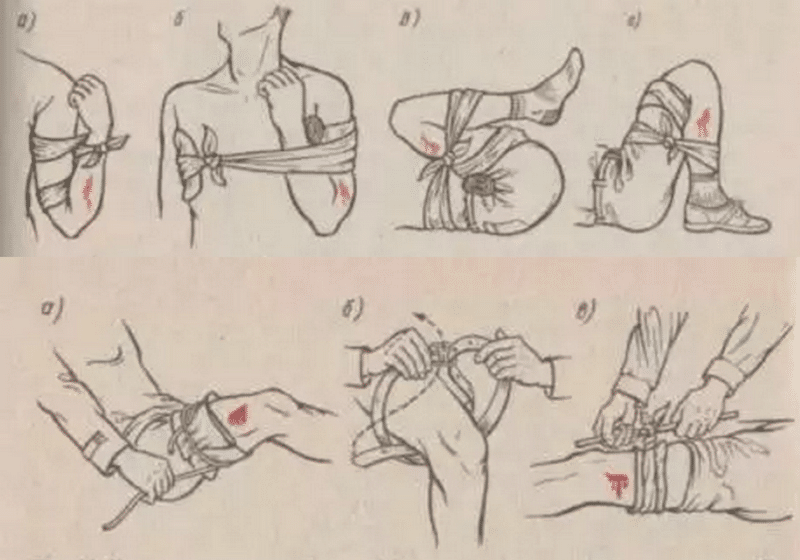
Stop bleeding
A closed fracture is characterized by swelling and redness. Pain similar to bruises. The problem area is fixed with a splint. Even a sheet of hard cardboard is suitable for its creation.
WITH open fracture there is a wound and bleeding. An additional tourniquet and all procedures with it are required. With fractures of the ribs, the victims are transferred either sitting or reclining. It is possible to fix the fracture, which is done during exhalation.
During exposure to fire clothing, do not run. It is necessary to extinguish it by removing the access of oxygen to the fire, covering it with a blanket or tarp. Areas of skin affected by fire are covered with sterile napkins. When the area is too large, then use a sterile sheet. In no case do not peel off clothes that are burnt to the skin.
You can carry the victims yourself on your shoulder, taking them on your hands or on your back. In case of fractures or open injuries, it is necessary to fix the bones or eliminate bleeding, and then transport.
Transportation of the injured to the hospital is allowed on the surviving car, but after that it is necessary to return to the scene of the accident to testify to the traffic police inspector.
Many believe that in an accident of any severity modern system safety in the car will save a person's life and health. But daily accident victims prove otherwise. How is it that the driver breaks his ribs on the steering wheel or gets injured when he hits the Windshield? This article will look at the main injuries in car accidents as well as ways to help the victim.
The most common accident injuries are:
TBI (traumatic brain injury).
Vehicle rollover injury.
Fracture of the cervical spine with a sharp "nod".
Feet clamp on the pedals.
Traumatic brain injury is the most common injury in a car accident. It often happens that the driver hits his head on the steering wheel. Such an injury, as a rule, is easy to identify: the victim has a broken face and bleeding is observed. Possible damage to the brain or spine, which entails serious consequences.
The only way to help a person with TBI is to treat the wound. Can't do any active action so as not to damage the spine. After treating the wound, you need to use the mobile ambulance call service so that the specialists hospitalize the victim and provide him with proper treatment.
During the rollover of the car, the driver, who forgot to buckle up, receives a series of blows on the roof of the car, seat and steering wheel. In this case, there can be many injuries. varying degrees gravity. Possible spinal fractures internal organs and various fractures. Often unfastened driver can be thrown out of the salons through the windshield.
In such a situation, it is extremely difficult to provide decent assistance to the victim. For example, when trying to give a heart massage, you can break the ribs of the driver. Therefore, if the eyewitness is not confident in his abilities, then it is better to call an ambulance.
During a head-on collision of cars, it is very likely to get a fracture of the cervical spine, since upon impact, the driver’s body moves forward by inertia, and then is thrown back sharply. As a result - a "whiplash" injury.
If the victim complains of severe pain in the spine and neck, then you should not touch him in any case, as the spine can be damaged. The victim should be put on the Shants collar and fix the neck, and then urgently taken to the hospital.
Often with head-on collision car, the injured driver is blocked in own car because the pedal assembly and upholstery pinch your feet. The most common injuries in such an accident are fractures of the femur and pelvic bones. In especially severe cases, it can go as far as amputation.
If eyewitnesses cannot free the driver, then it is necessary to remove the batteries from the car, thereby de-energizing it, and then call the Ministry of Emergency Situations, which has a clear procedure for dealing with such a situation.
And remember: advice will not always help to avoid injuries in car accidents, but it will significantly reduce the risk of an accident.
The rules of the road, approved by the Resolution of the Council of Ministers of the Russian Federation "On the rules of the road" dated October 23, 1993 No. 1090 (as amended, which entered into force on April 1, 2001), state that in the event of an accident, the driver involved in it is obliged “Take all possible measures to provide first aid to the victims, call an ambulance team and a disaster medicine center, rescue services. IN emergency cases send the victim on a passing, and if this is not possible, deliver on your vehicle to the nearest medical institution.
Currently, road traffic injuries around the world have taken on the character of an epidemic. At the same time, there is a clear pattern between the number of deaths in road traffic accidents (RTA) and the level of economic development of the country. The number of deaths in Russia (per 1 million cars) is 3-5 times higher than in countries with a developed road infrastructure. In our country in last years there is an alarming upward trend not only in the number, but also in the severity of injuries sustained as a result of traffic accidents.
Road traffic accidents are divided into the following types:
1. Collision;
2. Overturning;
3. Hitting a standing vehicle;
4. Hitting a pedestrian;
5. Collision with an obstacle;
6. Hitting a cyclist;
7. Hitting a horse-drawn transport;
8. Hitting animals;
9. Fall;
10. Other incidents;
Running over, being crushed and hit by a collision are the main traumatic factors that lead to damage and injury in a crash. Injuries are caused not only by cars, but also by road elements. Injuries in such cases are varied and complex. Naturally, the severity of the injury is primarily determined by the speed of the car. The most severe injuries to a person in a car are received by hitting the door, steering column, windshield. An analysis of fatal injuries showed that 52% of them were received as a result of deformation of the body, and 48% due to the impact of a passenger on the inside of the car.
The severity of damage resulting from an accident, in addition to speed, can be affected by the make of the car, its weight, the nature of the impact (frontal or tangential collision), the presence of an airbag and seat belts, and a safe steering column. The use of seat belts reduces the number of fatalities in frontal collisions by more than 3 times*.
*Among drivers and passengers who do not use seat belts, 46.3% are injured, 3% of road accident participants die. For people wearing seat belts, these figures are 19.2% and 0.8%.
The most frequent (more than 70%) and most dangerous injuries in road accidents are head injuries (bruises, compression of the brain, intracranial hematomas), injuries of the chest - chest and organs of the chest cavity - lungs, heart and spinal injuries (especially cervical).
The main causes of death of the victims are:
a combination of shock and blood loss - 40 - 50%;
severe traumatic brain injury - 30%;
trauma incompatible with life - 20%.
In addition, the causes of high mortality are the temporary factor (late medical care) - the rule of the "golden hour" and the low level of training of drivers and employees of the traffic police of the Ministry of Internal Affairs of Russia in the methods and skills of providing first aid to victims.
An automobile injury is an injury caused by external and internal parts a moving vehicle or arising from falling out of it. There are the following types of car accidents:
1. Hit by car parts in a collision with a person;
2. Moving by wheel or wheels;
3. Falling out of the car;
4. Impact on a part or compression of the body by parts of the car in the cab;
5. Compression of the body between parts of the car and other objects;
6. Combined type of injury.
Damage resulting from a collision with a moving vehicle (collision) is the most common. This type of autotrauma includes several successive stages.
1. Collision of car parts with a person. The mechanism of damage is a blow and a general concussion of the body. Damage occurs on clothing and body, showing the contours of a part or edge of a bumper, headlight, radiator lining, etc.
Localization of injuries - lower limbs, pelvic region, less often - torso, at the level of those parts of the car with which they were inflicted (contact injuries, stamp-damages).
2. Fall of the body on the car. Mechanism - hitting a part of the car (hood, fender, windshield wiper fitting, etc.).
Localization - areas of the head, torso, upper limbs. It should be borne in mind that the throwing of the body onto the car occurs during the initial impact below the center of gravity of a person (when hit by a passenger car). If the primary impact is delivered near the center of gravity (by a truck, bus, etc.), the body is thrown forward.
3. Throwing and falling of the body to the ground. Mechanism - impact on the ground. Localization - the area of the head, trunk, upper limbs.
As a result of a collision, the human body acquires a speed close to the speed of the car, as well as rotational movement around the longitudinal axis.
Sliding body on the ground. Mechanism - friction on the ground.
When colliding with a moving vehicle special meaning have the so-called bumper injuries arising from hitting the thigh or lower leg with a bumper, depending on the height of its location. On the skin at the contact points, a transverse banded bruise, abrasion or wound often occurs. Of particular importance is a transverse comminuted fracture of the bones of the lower leg and thigh. In the fracture area, in typical cases, a large wedge-shaped fragment is detected, the base of which shows the place, and the sharp end shows the direction of the blow.
As a result of hitting parts of the car, falling of the body on the car, throwing it to the ground, injuries to the soft tissues of the head occur, as well as fractures of the bones of the skull. More often these are straight, closed, linear and comminuted fractures. Combined fractures of the bones of the vault and base of the skull are often observed. Linear and comminuted fractures originate at the site of impact and spread radially in different directions in the plane of injury, as if graphically outlining the direction of impact on the skull. Injuries to the brain, its membranes, blood vessels occur at the site of application of force and in areas remote from the impact site (in the area of anti-impact).
A strong blow to the upper thighs and pelvic region often results in straight, linear, or comminuted pelvic fractures. Such fractures are often accompanied by damage to the pelvic organs. When struck from behind, the cervical and upper thoracic spine are often damaged as a result of a sharp excessive extension of the body.
Injuries from a hit by a truck, bus or trolleybus are often localized in the chest area. In this case, damage can occur from objects with an extensive or limited (when hit by protruding parts) traumatic surface. A blow to the chest results in unilateral (usually direct) multiple rib fractures occurring at the point of direct application of force.
A blow by a car with subsequent throwing of the victim is often accompanied by a complex of indirect injuries of internal organs due to concussion of the body. The most commonly damaged liver, lungs, kidneys and spleen. The organs of the abdominal cavity are damaged more often than the chest.
In the so-called crossing of vehicles through the body of the victim, a complex of injuries occurs, which is characteristic of this mechanism of injury. Firstly, hemorrhages are formed that reflect the wheel tread pattern, secondly, exfoliation of the skin and other tissues is formed in the form of pockets filled with blood, and thirdly, there are traces of body dragging in the form of extensive abrasions. When moving the wheel through the chest or abdomen, ruptures and crushing of internal organs are often observed. With the same impact on the head, there remain: its significant deformation, comminuted fractures of the bones of the skull and crushing of the brain.
The driver's injury inside the car during a head-on collision is characterized by a complex of injuries arising from the action of the steering wheel, instrument panel and windshield in the form of bruises and compression of the chest and abdomen, accompanied by fractures of the ribs, ruptures of internal organs. From the windshield damage in the form of bruises, wounds and abrasions are localized on the face and head.
It is believed that the car body and safety systems, even in the most severe accident, should save a person. But even in relatively new cars, after a blow, the driver’s legs find themselves in the web of the pedal assembly, the ribs are broken about steering wheel, and on the windshield - a characteristic dent. What injuries are most common for motorists? And is there any way to save yourself? And how justified?
It is believed that the car body and safety systems, even in the most severe accident, should save a person. But even in relatively new cars, after a blow, the driver's legs find themselves in the web of the pedal assembly, the ribs are broken on the steering wheel, and there is a characteristic dent on the windshield. What injuries are most common for motorists? And is there any way to save yourself? And how justified is the position of many eyewitnesses of the incident - "I'm not a doctor and I won't help, so as not to make it worse"? We turned for comment to those who usually arrive first at the scene of accidents - rescuers of the Ministry of Emergency Situations.
“When you see a characteristic mark on the windshield…”
TBI is the most common injury in car accidents. When you arrive and see a characteristic mark on the windshield, you don’t even need to ask whether the driver was wearing a seatbelt or not. Everything is already clear, - says the ambulance doctor of the Republican detachment special purpose Ministry of Emergency Situations Sergey Zhuravlev. - Drivers often hit their heads on the steering wheel. Especially in those cars where it is located almost horizontally. As, for example, in old VAZs. During a side collision (which is actually more dangerous than a frontal one, especially if there are no side airbags), it is not uncommon for a head to hit a side pillar or a door. Such injuries, as a rule, do not happen in isolation: people have a broken face, damaged soft tissues of the head, and bleeding is observed. The brain can be damaged, which will lead to serious health consequences.
If a person has received a head injury, then the maximum that eyewitnesses can help is to treat the wound. But attention: extremely carefully - without active actions, so as not to cause more harm, for example, in case of damage to the cervical spine. However, bleeding in such cases usually does not threaten life and does not require intervention from eyewitnesses, the rescuers warn. - Well, to prevent TBI, you need to buckle up, even if you are driving a short distance. It is a mistake to assume that at a speed of 60 km / h it is impossible to get a serious injury. Easy!

There is one more nuance - you can get a traumatic brain injury after an accident. Sometimes airbags that did not work at the time of the accident can “shoot” a little later and injure a person. In this case, the Ministry of Emergency Situations has a so-called anti-airbag, which blocks the airbag.
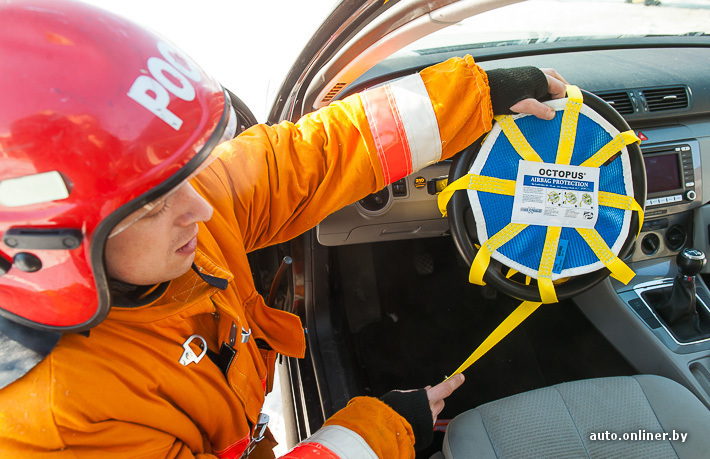
During a car overturn, the driver receives a series of strong blows.
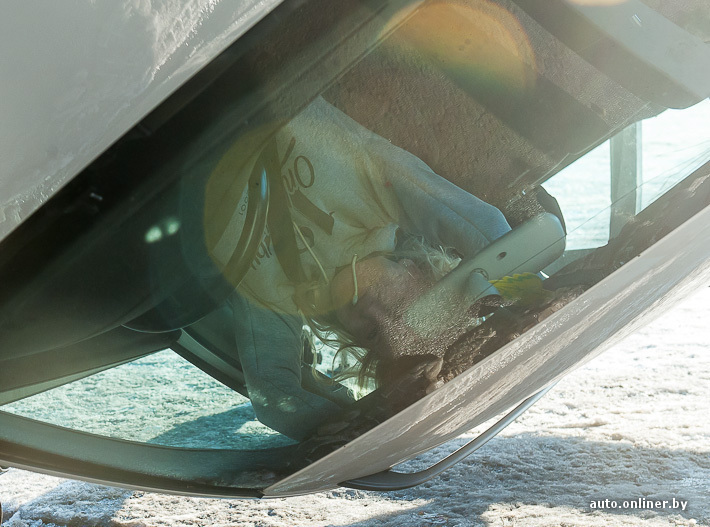
During a car rollover, an unbelted driver receives many hits on the roof, dashboard, chairs, steering wheel, etc. Usually in the summary in such cases they write: "the victim has numerous injuries of varying severity." Medical workers call it a combined injury, that is, a combination of injuries when several anatomical regions are affected at once, representatives of the Ministry of Emergency Situations say. - We are talking about fractures, injuries of the spine and internal organs, again TBI, etc. Very often in such cases, an unfastened driver is thrown out of the passenger compartment - through a windshield or even a side window.
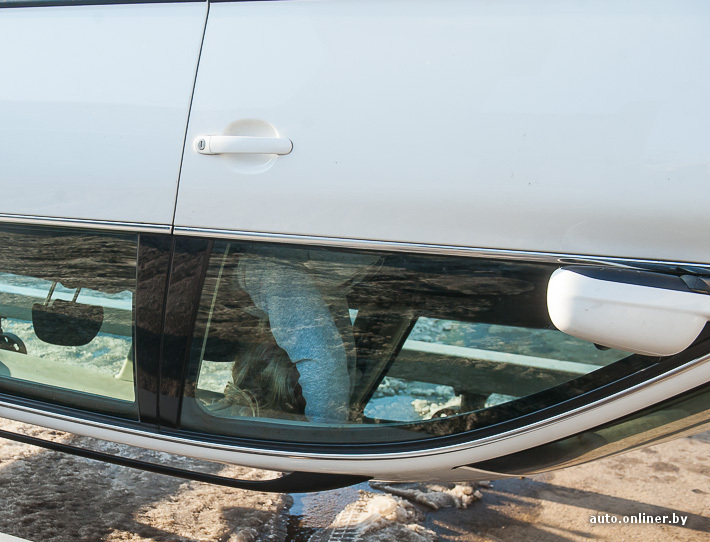
What should eyewitnesses do and how can the driver protect himself?
The basic principle of eyewitnesses should be “do no harm”, but you need to proceed from a specific situation. If a person is absolutely sure that he can do better, then let him act. I'm not sure - we have to wait for the professionals, - Sergey Zhuravlev believes. - In my practice, there was a case when the witnesses of the accident, trying to do an indirect heart massage, broke the ribs and sternum of the victim. What is called, rescued as best they could. This is one extreme. The other is the indifference of others. At least approach the car in case of an accident and ask how you can help, it's not difficult. My friend had an accident on the M1 highway last year - her Renault Scenic turned over onto the roof. She herself was strapped seat belt, her child was in child car seat. The woman had a broken arm, the baby was not injured. But none of the eyewitnesses approached, and they hung there until the arrival of our colleagues from the regional department of the Ministry of Emergency Situations.
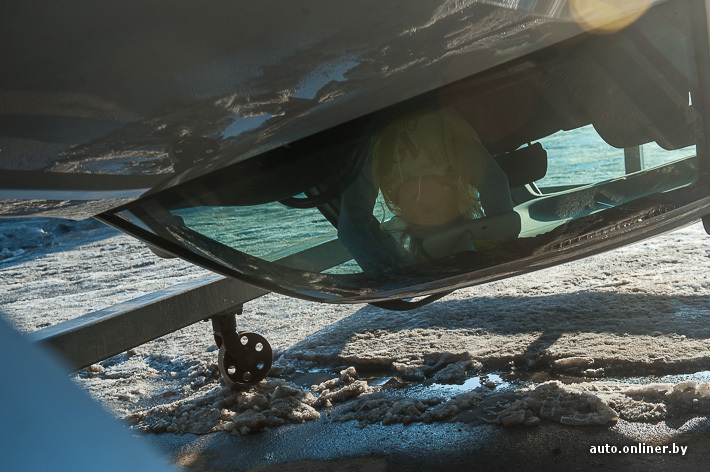
By the way, it is not so easy to cut the seat belts, the locks of which are often blocked as a result of an accident, and usually there is no knife at hand. Rescuers in this case have special tool.
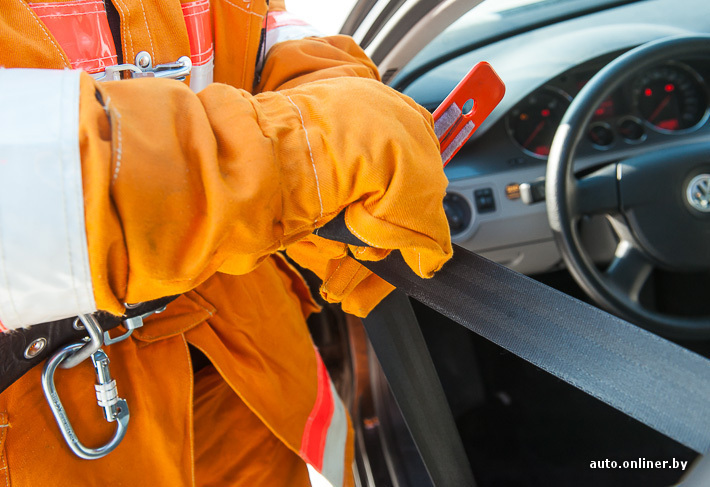
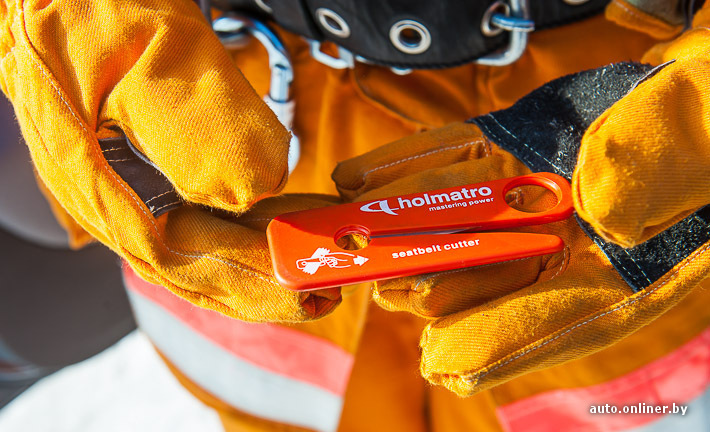

A sharp nod breaks the cervical spine
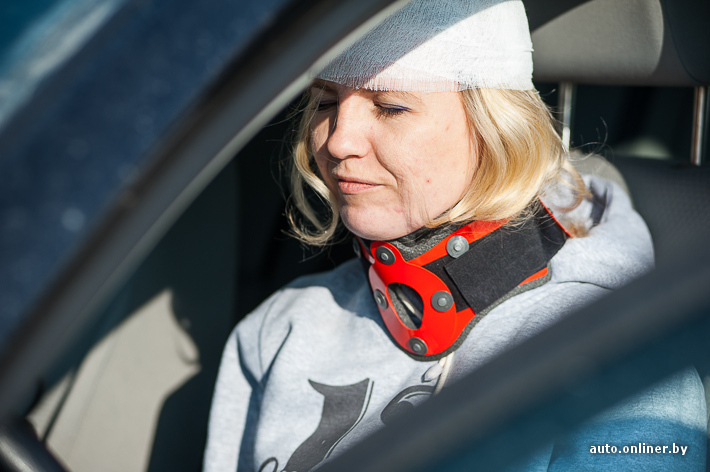
There is a risk of serious injury even in a passing collision. For example, a fracture of the cervical spine. During the impact, the driver's body is pushed forward. There is a sharp nod of the head, and then it is thrown back. All this happens in a fraction of a second by inertia, - says Aleksey Novitsky, operational duty officer of the Ministry of Emergency Situations. - As a result, the driver receives a so-called whiplash injury.
What should eyewitnesses do and how can the driver protect himself?
When an injured driver complains of pain in the neck, in no case should you touch him - you can damage the spinal cord, since the pain syndrome can be caused by a fracture of the spine, explains Sergey Zhuravlev. - A Shants collar is applied to such a victim, which rigidly fixes the neck. The person is then sent to a hospital where a clinical diagnosis is made.

According to rescuers, a properly adjusted headrest can protect against the so-called whiplash injury. Many people think that it was invented solely for the comfort of the driver and passengers, but this is not so. Whiplash can also be caused by an improper driving position. Most of the drivers, please note, rides hunched over. The back of the motorist does not fit snugly against the back of the chair, and the head - to the headrest. This gives freedom of movement, which in the event of an accident can play a cruel joke on the driver.

Feet get stuck on the pedals
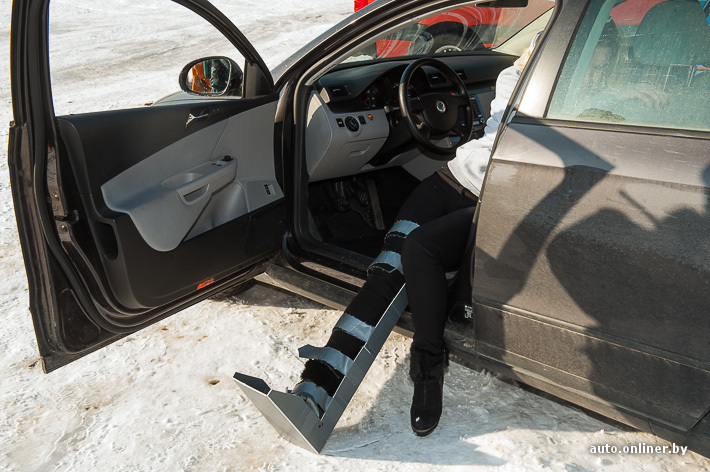
Sometimes drivers find themselves locked in the car, especially in a head-on collision, says Aleksey Novitsky. - As a rule, the pedal assembly and interior trim elements pinch the legs. Moreover, a lot depends on the design of the car: if its body effectively dampens the impact energy, and the engine “goes” down without flying into the passenger compartment, then the consequences will be less severe. Typical injuries in such situations are fractures of the bones of the lower leg, thigh, and pelvis. It can go as far as amputation of the lower extremities. So it was with a very young passenger Mercedes on the street. Altai, where this car crashed into a pole. The most difficult thing is to get close to the pedals and cut them, they literally twist into a web. The whole difficulty is that you need to work extremely carefully, without harming the victim. Usually a small hydraulic tool is used.
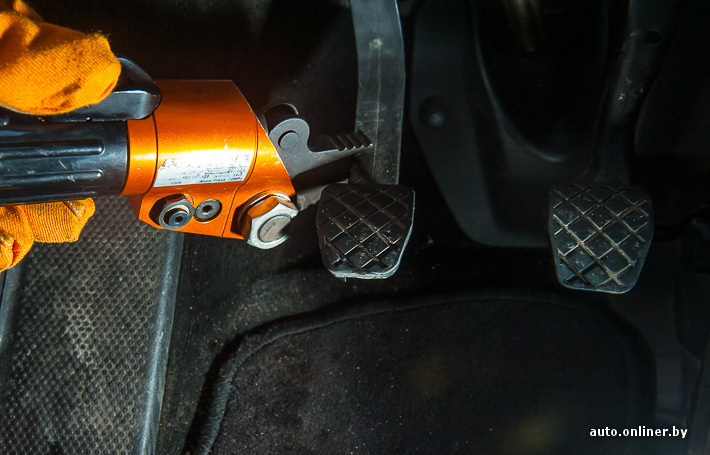

What should eyewitnesses do and how can the driver protect himself?
In cases where a person is trapped in a car and it is not possible to free the victim, eyewitnesses need to turn off the car (if the engine is still running) and de-energize it, that is, disconnect the battery terminals, ”explains Semyon Sak, First Deputy Head of the ROSN. - The combat crew of the Ministry of Emergency Situations has a clear procedure. One disconnects the battery. The second cuts the racks or roof, making it easier to access the victim. The third finds out the state and tries to determine the pulse, check the breathing, heartbeat. But before you save a person, you need to secure the place of work. This rule is. During an accident in which a car sustains significant damage, a spill occurs technical fluids and there is a risk of fire: wiring insulation is often broken. Any spark - and fuel vapors will flare up. This is not an exaggeration: a few years ago, on the Moscow Ring Road near the XXI century business center, a driver who had an accident was burned alive. There was no one nearby who would have guessed to disconnect the battery.

Ribs break on the steering wheel

Another characteristic injury for a driver is a fracture of the ribs and sternum, continues Sergei Zhuravlev. - The blow falls on the steering wheel, which is often even deformed in an accident. Imagine what happens to human bones! There is a risk of traumatic pneumothorax (accumulation of air in the lungs). Usually on accident scene the victim is given a special fixator UShS (folding tire device). Then several people carry the driver onto a stretcher, which they bring as close as possible to the car in order to cause as little discomfort as possible to the injured person.



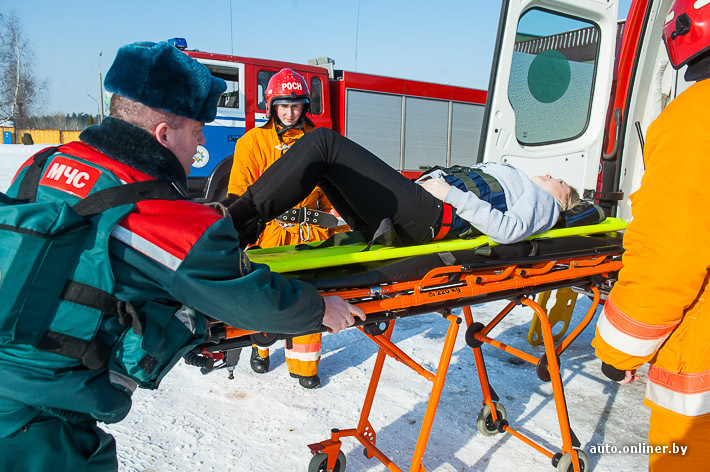
What should eyewitnesses do and how can the driver protect himself?
Again, we need to proceed from the situation. If others do not know what to do, then it is better to do nothing, remind the rescuers. - But, for example, it is quite possible to give a person an anesthetic. The need for urgent care is only in case of open bleeding. You can stop it by applying a tourniquet - this is the little that remains in the driver's first aid kit. But many do not know how to do it right. The tourniquet is applied only to the thigh or shoulder. In the case of arterial bleeding (blood color is scarlet, and it pulsates) - above the wound, and venous (blood is dark, and the pressure is not so strong) - below the wound.
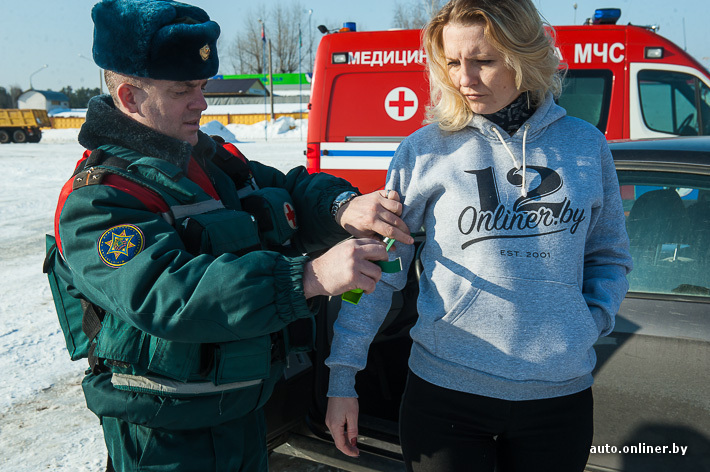
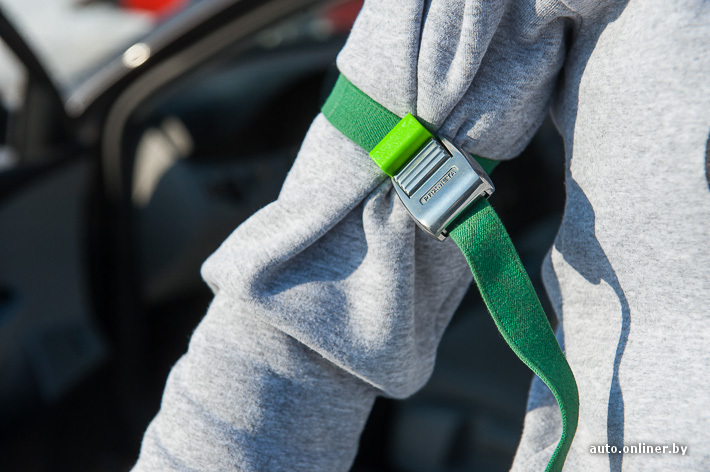

The rear passenger strikes a crushing blow

The Swedes had a campaign during which they declared: "You are carrying an elephant"- give an example of employees of the Ministry of Emergency Situations. - I meant, of course, not a real elephant, but a passenger with rear seat, whose body in an accident receives sharp acceleration and falls on the chair in front of the person sitting with a force of several tons. Thus, the driver receives another blow and, as a result, spinal injuries, TBI, rib fractures, etc.
What should eyewitnesses do and how to protect themselves?
Again, the obvious advice: watch more than just your seat belts. Unfastened passengers not only can injure themselves, but also harm other people in the cabin, representatives of the Ministry of Emergency Situations draw attention. - We are often asked: have there been cases when the belt, on the contrary, prevented you from surviving? It’s hard to say for sure, but in several situations, drivers were really thrown out of the passenger compartment and this could rather be considered a boon. Would they have been able to survive otherwise? big question. But, again, these are rather exceptions.
 Sergei Zhuravlev
Sergei Zhuravlev 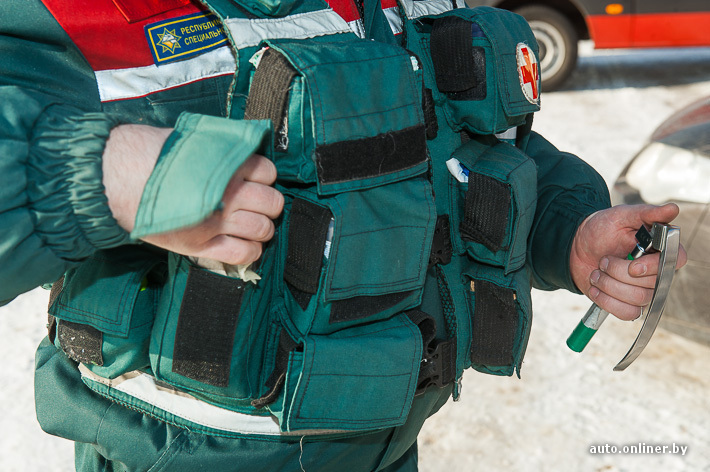 In the pockets of the vest - everything you need to provide first aid
In the pockets of the vest - everything you need to provide first aid 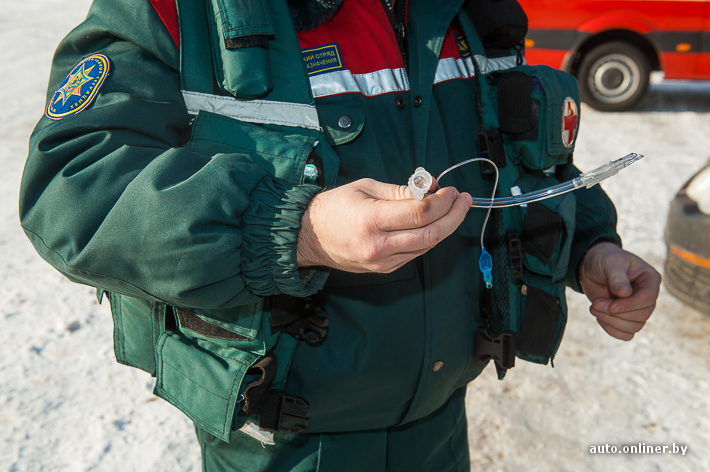

The belted driver usually has a bruise from the belt and a broken collarbone
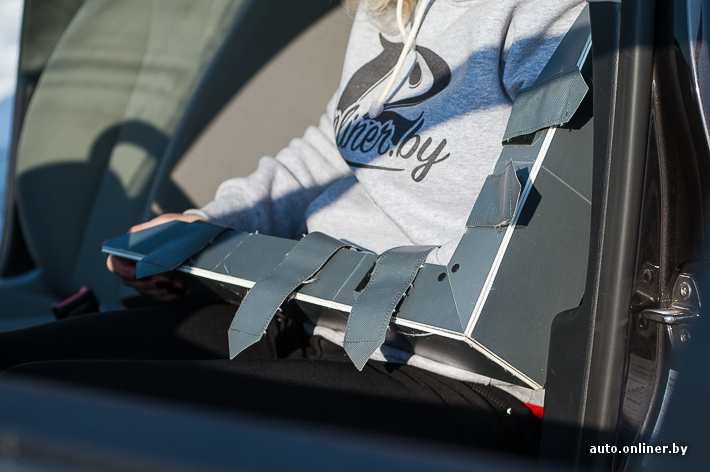
In the chest area of the victim in an accident, on examination, manifestations of a subcutaneous hematoma can be seen. These are traces of a seat belt, - says Sergey Zhuravlev, who for a long time worked as a resuscitator in hospitals. - And since the strapped person is rigidly fixed in the chair, there is a risk of also getting a fracture of the collarbone. If the driver had not used the seat belt, he could fly out through the windshield.
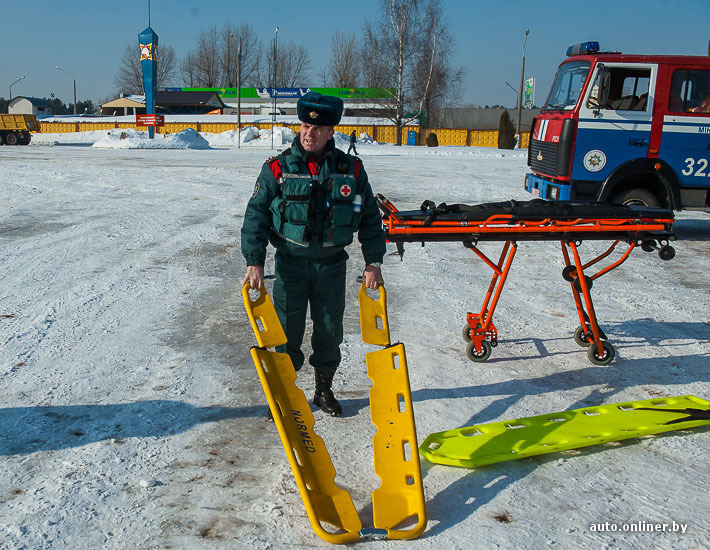 bucket stretcher
bucket stretcher What should eyewitnesses do and how can the driver protect himself?
If a person understands that a collision is imminent, then you need to group up, - the employees of the Ministry of Emergency Situations advise. - In this case, the muscles of the body contract and the risk of injury is reduced. Just do not need to believe that in this way you can avoid injury altogether. No, it's just that its consequences will not be so severe.
The entire face of the driver is scratched
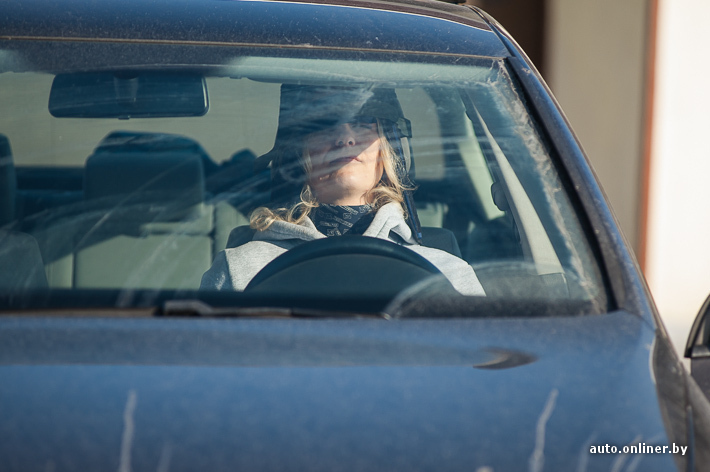
Minor injuries that can be sustained during an accident also include multiple cuts. For example, from fragments of glass that broke during an accident, Sergey Zhuravlev notes. - Sometimes drivers and passengers even get an eye injury. My friend, who was in an accident, accidentally escaped such damage. He wears glasses, and at the time of the accident they saved his eyesight.
What should eyewitnesses do and how can the driver protect himself?
Here you can only wipe the blood off your face, but only in compliance with safety standards - wearing gloves and disinfecting wounds, the rescuers advise. - Threats to life in this case No.
Employees of the Ministry of Emergency Situations often have to break windows in cars themselves (as a rule, doors are blocked as a result of accidents). For this, another special tool the size of a regular felt-tip pen is used. The spring is pulled, the metal rod hits the striker, the tip of which is made of an alloy of hard metals. Despite the small size of the tool, it can be used to quickly access the victim in the car.


Summing up, the rescuers reminded: “Not in all cases, advice will help to avoid injuries in car accidents, but it will definitely help to minimize the consequences.”
Growth in quantity road transport in the Russian Federation, low discipline of drivers and pedestrians, unsatisfactory condition of roads are accompanied by an annual increase in the number of traffic traffic accidents, as well as victims, including fatal. In 2006, the World Health Organization published a report according to which more than 1,200,000 people die every year in traffic accidents worldwide and another 50 million are injured. Every day, 3,000 people die on the roads, most of them are young people aged 15 to 44. In 2002, people aged 15-44 accounted for more than half of all road deaths worldwide. 73% of the total number of deaths are young men. Road traffic death rates vary significantly across regions and across different countries and regions.
One of the most difficult questions forensic medical examination in cases of autoinjury, is to establish the mechanism of occurrence of autoinjury by the nature of the detected injuries. According to a number of authors (V.K. Steshits, 1954, 1972; A.A. Solokhin, 1960, 1972; A.A. Matyshev, 1963), a comparison of the morphology of experimental injuries with similar injuries encountered in everyday practice helps to solve many problems. questions in the examination of cases car injury. Modeling of various mechanisms of autoinjury is extremely necessary for the introduction of technical improvements in vehicles, improvement of the rules for operating vehicles, aimed at improving the safety of road transport. The participation of specialists in the exact sciences - mathematicians, engineers allows not only to calculate physical characteristics dosed loads in experiments, but also theoretically determine their value using mathematical calculations. So, A.A. Solokhin and R.Kh. Abdukarimov (1991), together with specialists in the field of mathematics and computer technology, developed an algorithm and created the program "EDDS of types of car injury (hit, crossing)". They, based on the analysis of literature data, archival and own observations, developed a coded complex of morphological signs-damages. This made it possible to compile a table with damage signs with high informative significance for injury both from a blow by parts of a moving car on a person’s body, and from moving a body by a car wheel.
In case of injury inside the car, two phases are distinguished in the mechanism of damage formation: collision of the body with parts and details of the car cabin (mandatory phase); squeezing the body between the displaced parts of the cabin (optional phase). Occasionally, an injury inside the car can occur from the sudden introduction of foreign objects into the passenger compartment (cabin). Impact plays the main role in the mechanism of damage formation inside the car, however, squeezing by displaced parts of the car, shaking, excessive flexion or overextension (for example, of the cervical spine), etc.
The occurrence of damage in this type of injury is caused by the impact of the body of the victim due to inertia on the parts and mechanisms of the car during sudden stop or change in the nature and direction of its movement. At the same time, according to Shchegolev P.P. (1959), damage resulting from a collision of cars or collisions with stationary objects is different from damage due to rollover, overturning of the car, falling from a height. The most dangerous are collisions of cars and their collision with fixed objects, especially the front of the car. The author notes that in case of an injury inside the car, the signs of the impact of a large mechanical force are manifested to a lesser extent than in other types of car injury. Therefore, the phenomena of general concussion of the body in these cases are not expressed. With this type of injury, there are no phenomena of body compression, which are characteristic of moving, being pressed by a car, damage that occurs during dragging, etc. With this type of injury, there is no typical impact great strength inconsistencies of minor external injuries with extensive destruction of the skeleton and internal organs. The author points out that of particular importance in this mechanism of injury is the fact that damage occurs not only from blows against blunt objects, but also as a result of the impact of glass fragments, instruments and other objects in the car. Characteristic of an injury inside a vehicle is the injury to the victim in a sitting position, which should be taken into account when measuring the height of the injury. In case of injury inside the car, damage to the head, chest and lower extremities predominates. At the same time, head injuries in drivers are observed two times less often than in passengers. The nature of the damage and the frequency of their occurrence is related to the location of the victim in the car. According to P.P. Shchegolev (1959), injuries to passengers were observed twice as often as injuries to drivers, which corresponds to the literature data (E. Guardian, K. Strait). Passengers, being predominantly in a relatively relaxed state, do not always have time to understand what is happening and concentrate in time, which leads to their easier displacement towards traumatic objects. Most dangerous place in the car is the front passenger seat. Passenger damage front seat differ in frequency and severity. K. Strait called the front passenger seats "the seat of death." The driver during an accident is usually a little more advantageous position than the passengers, as his attention is concentrated, and his body is more fixed by the emphasis on the pedals and steering wheel, especially in the last moments before the accident. Absence significant damage the driver, taking into account other conditions, indicates a relatively low speed of the car. E. Gardin, D. Webster, N. Lissner indicate that when high speeds hitting the steering wheel with the chest causes fatal injuries to the driver; in addition, the driver is also injured when hitting the windshield. The main criteria for a forensic assessment of a person’s location in a car are: localization of deposits, bruises and bruised wounds, massiveness of injuries, localization and nature of “punching marks” reflecting the relief of damaging objects (V.K. Ivanov, Yu.S. Sidorov, 1990; P .P. Shchegolev, 1959). However, the solution of the question of the location of the victim at the time of the accident only by the nature of the mechanical external injuries of the human body is difficult, since injuries to drivers and front seat passengers occur with approximately the same frequency (Yu.S. Sidorov, 1969). Drivers and passengers have almost the same damage to the front surfaces of the knee joints and the upper thirds of the legs from a blow to the control panel, up to fractures. Passengers, unlike drivers, have multiple incised wounds of the soft tissues of the hands and forearms from fragments of wind or side window(A.A. Solokhin, 2001). In addition, passengers tend to have more severe skull fractures than drivers and are more likely to have fractures of the cervical spine. Therefore, a number of authors point out the need to pay attention to a comprehensive study of clothing, footwear, car damage, as well as to detect traces of interaction on them. External injuries in case of injury inside the car are located mainly on the front surfaces of the body. Splinters are found in the soft tissues of the body, in the folds and in the pockets of clothing. automotive glass. On the soles of the driver's shoes, you can see the imprints of the control pedals, traces of friction on them, and the separation of the heel. When the car rolls over, it is possible that the body is squeezed between part of the car and the ground. In such cases, signs of compression are found on the corpses. The authors draw attention to the fact that damage to the clothes and shoes of the victims is detected not only when hitting a fixed obstacle, but also when cars collide. When examining the shoes of persons injured inside the car, traces of damage are observed both in the upper area of the shoe and on the sole surface in the form of surface abrasions of irregular shape, arcuate shape, in the form of stripes and scratches (V.K. Ivanov and Yu. S. Sidorov, 1990). In the works of these authors, for example, it is indicated that when examining the sole surface of shoes, it is necessary to pay attention to the presence of parallel tracks resembling slip marks; on traces of lapping from the brake and clutch pedal, rug; on various kinds of impositions and inclusions. The injuries found on the body of the victim in comparison with the damage to the car and taking into account other circumstances of the case make it possible to fully restore the objective picture of the accident. To recognize who was the driver and who was the passenger, you can focus on a number of signs. At the driver of the car frontal collision quite characteristic damage can be formed:
I. Damage from the interaction of the feet with the pedals and the floor:
- damage to shoes in the form of an imprint on the sole of the relief of the pedal, tears in the toe area, tearing off the heel;
- bruising of the plantar surfaces of the feet, damage to the bones of the feet;
II. Damage from the interaction of parts of the driver's body with the steering wheel:
- ruptures of gloves between the first and second fingers, damage to the thumbs of the hands and the corresponding interdigital fold, bruising of the palms in the area of the eminences of the 1st and 5th fingers;
- bruises and abrasions on the inner thighs from hitting the steering column;
- varying degrees of severity of damage to the chest or abdomen from hitting the steering wheel (depending on the design features of the car), while hitting the steering wheel with the stomach can damage the internal organs of the abdominal cavity, and hitting the chest can damage the chest organs;
- arched bruises, deposits, sometimes bruised wounds on the abdomen, anterior surface of the chest, shoulders from hitting the steering wheel in combination with rounded or arched injuries of a smaller diameter in the sternum from the impact of the steering wheel bushing;
- various injuries of the face from hitting the steering wheel (bruises, bruised wounds, especially of the lips in combination with damage to the teeth and damage to the lips with inside from teeth), up to local fractures of bones.
III. Cabin door parts damage:
- These damages in drivers of vehicles intended for right-hand traffic, are located on the outer surface of the left thigh, on the left arm, and for passengers - on the right side of the body. With a different location of the steering wheel, everything changes places.
IV. Seat belt damage:
- Seat belts injure the driver in the region of the left shoulder girdle, on the anterior surface of the left half of the chest and on the right half of the abdomen, while the passengers injure the upper half of the body on the right and the stomach on the left.
In the works of other authors (A.P. Gromov, 1979), there are indications of an existing certain pattern between specific quantities active forces and features of the occurrence of injuries (abrasions, bruises, wounds, fractures). The revealed patterns allow in practice to establish the mechanism of injury and the magnitude of the acting forces according to the detected injuries. The study of the strength limits of bones to static and dynamic loads is of considerable interest for the development of such a science as biosopromat. Modeling in forensic traumatology is of great importance both for forensic science and practice, and for a number of clinical disciplines, primarily traumatology and sports medicine. Modeling of various mechanisms of autoinjury is extremely necessary for the introduction of technical improvements in cars, the development of individual protection methods, and the improvement of the rules for operating vehicles aimed at improving the safety of road transport. A.P. Gromov together with the staff of the Department of Forensic Medicine 1 MMI. Sechenov developed methods for obtaining dosed injuries to the head and spine, simulating an injury inside the cab of a car (hitting the head on the windshield and other parts of the car, “whiplash” injuries to the head). These techniques made it possible to obtain damage to the head and spine of a moving body, depending on the speed of impact, the force of impacts, the resulting overloads, the elastic properties of the impacted surfaces (recovery factor). In the process of experiments, the location of the center of gravity and the moment of inertia of the body, the angular and linear velocities, the shock impulse, and the impact time are simultaneously determined (A.P. Gromov, 1969).
The study of the structure of injuries in a car injury confirms the already known pattern about the predominance of multiple and combined injuries in this type of injury (V.F. Trubnikov and Istomin, 1974, 1977; A.V. Kaplan and V.F. Pozharsky; M.N. Farshatov and et al.). A number of authors indicate that in almost 70% of cases in road traffic accidents there is a multiple nature of damage (G.G. Omarov, T.R. Ashurbekov, B.M. Lisyansky, D.A. Tonaev, 1991). B.N. Aitmyrzaev, V.K. Ivanov and Yu:S. Sidorov (1969, 1990) present the data of their study on the identification of the morphology of head injuries and the frequency of occurrence, the latter in victims inside the cabin (for drivers and front seat passengers) in frontal collisions cars. The forehead, nose, zygomatic and chin areas of the face were most often injured in front seat drivers and passengers, where abrasions were observed (81.4% and 61.6%, respectively), bruises (55.7% and 40%, respectively), bruised wounds (62.8% and 54.8%, respectively), hemorrhages in the soft integument of the head (48.6% and 38.4%, respectively). Drivers were more likely to have bruised wounds and hemorrhages in soft tissues - the integument of the parietal regions of the head, and front seat passengers - bruises. Fractures of the facial skeleton, temporal bones, bones of the vault and base of the skull were found more often in drivers than in front seat passengers. Subarachnoid, subdural hemorrhages and focal hemorrhages in the substance of the brain were more common in drivers, and the passengers of the front seat were most often bruised and crushed in the substance of the brain. The main sources of head injury among drivers were such parts of the car interior as the steering wheel assembly with the steering column, windshield, rear-view mirror, front pillar of the car body, less often the ceiling. The passenger of the front seat has a windshield, the front side wall of the car body, the instrument panel, the ceiling is somewhat less common (Yu.S. Sidorov, 1969; P.P. Shchegolev, 1959).
In the forensic literature, the issue of differential signs of injuries in drivers and passengers is still insufficiently studied. A. Rakhimov (1956), A.A. Solokhin (1968) indicate that injuries in drivers are located on the left, and in passengers - on the right anterolateral surface of the body. P.P. Shchegolev (1959), and later Yu.S. Sidorov (1969) analyzed injuries in drivers and passengers to identify the features of the localization and nature of injuries that occur during a car collision. An analysis of the nature and localization of injuries in drivers and passengers indicates that various injuries in the aggregate are located on the left anterolateral surfaces of the body for drivers, and for passengers on the right, which confirms the data of A.A. Solokhina (1968), P.P. Shchegolev (1961), L.E. Roenko (1967) in his work conducted a study during which he confirmed the frequency of occurrence of chest injuries in case of an injury in the passenger compartment of a car. Chest injuries rank third after head and lower extremity injuries. So, according to his data, chest injuries were observed in 19.34% of cases, head injuries - in 36.9% of cases, damage to the lower extremities - 23.7%. Chest injury was more common among car drivers, in second place this species injury was observed in front seat passengers. At the same time, according to P.P. Shchegolev (1955) and A.A. Solokhin (1958, 1968), front seat passengers are more likely to get this injury. Injuries to the chest in the driver occur from hitting the steering wheel, in the passenger of the front seat - from hitting the control panel and instrument panel, as well as the back of the seat. The author considers the influence of the design features of the parts of the car interior on the mechanism of occurrence, and on the nature of the resulting damage. So, he studied the mechanism of damage formation depending on the diameter of the steering wheel, the thickness of its rim and other features, the angle of inclination. In this regard, the body of the driver in the cab truck first it comes into contact with the wheel rim, which causes its pronounced effect on the chest, creating conditions for the occurrence of sharp bends of the body through the steering wheel. The author notes the influence of the material, shape and elements of the car interior parts (front seat backs) on causing damage. Based on the material studied, the author points out that rib fractures and damage to internal organs were observed in accidents where the vehicle speed reached 60 km/h or more. At lower speeds, damage to the soft tissues (bruises, abrasions, bruises) of the chest took place. According to the author, the mechanism of chest injury inside the car consists of the following components: a blow from the chest against a part of the car, a blow and compression of the chest due to inertia, compression of the chest by displaced parts of the car, a sharp bend of the chest through the parts of the car, a counterattack when the body is thrown after the hit. The impact of the body on a part of the car is more typical for low collision speeds (up to 60 km/h). In this case, damage occurs from direct impact. Impact and compression occur at speeds above 60 km / h, when, due to kinetic energy, the chest wall hits the front surface of the part of the car located in front of it, after which its rear surface bends forward, causing damage to the flattening of the chest. In this case, damage occurs that is characteristic of both direct and indirect impact. With a sharp flexion of the chest due to the emphasis of its lower part on the steering wheel, control panel or front seat back, spinal injuries such as compression fractures occur. Posterior thoracic injuries are caused by impact with the seat back in anteroposterior collisions or due to the body being thrown back after impact. However, in their work, these authors did not study the relationship between various types collisions of cars, the frequency and localization of damage to the ribs of drivers of vehicles. Yu.S. Sidorov and L.A. Shcherbin (1990) conducted a study that studied the general patterns of rib fractures along various anatomical lines in car drivers in frontal, frontal-left (right) and lateral left (right) collisions Vehicle. They established a statistically significant movement of rib fractures according to the direction of the dynamic impact on the car. In lateral left collisions, fractures were noted almost exclusively on the left side of the study area, and were located mainly along the middle and anterior axillary lines. In cases of frontal-right collisions of cars, the total number of fractures of the ribs of the right half of the chest was 69.7% of the total number of fractures of the ribs. The study has confirmed a significant relationship between the direction of the dynamic impact on the car, the frequency and localization of rib fractures in vehicle drivers. . This situation indicates the incomplete use of the possibilities of forensic medical examination (O.F. Saltykova, I.I. Antufiev, N.N. Veremkovich, L.A. Shcherbin, Yu.S. Sidorov, O.A. Romodanovsky, 1969) . A negative practice is when a forensic expert is never called to the scene in cases where the incident did not end in a fatal outcome (O.Kh. Porksheyan, SI. Khristoforov, 1965). In these cases, the investigator does not ask about the mechanism of damage formation, being interested only in the degree of their severity. This leads to a mechanical translation of these medical documents into one or another group of severity. A personal inspection of the scene, transport, clothing of the victim, combined with an objective picture of the damage, allows the expert to establish detailed mechanism their formation, recreate the picture of the incident. A. Rakhimov (1970) in his work on the study of non-fatal motor vehicle injuries shows that it is in cases with a non-fatal motor vehicle injury that there is a maximum of opportunities to find out the mechanism of damage. In these cases, the expert deals, as it were, with an "experiment", where all the initial data are known (the place of the initial impact, the subsequent traumatic effect, the speed of the car, the nature of the path, etc.), where the damage can literally be compared with the localization and nature of those protruding parts of the car by which they were successively caused.
Due to their procedural position and a large amount of information on a wide variety of parameters, forensic experts make a significant contribution to the investigation of an accident, as they conduct a medical reconstruction of the accident and establish causal relationships of the consequences of an accident. In their works, a number of authors emphasize that experimental modeling of damage in various options experiments set up with previously known physical parameters of dynamic loads, would provide the necessary data for a more directed expert assessment of injuries to the human body and the factors that cause them (O.F. Saltykova, I.I. Antufiev, N.N. Veremkovich, L.A. Shcherbin, Yu.S. Sidorov, O.A. Romodanovsky, 1969). So, I.I. Antufiev, V.M. Boytsov, V.B. Lemasov, A.V. Maslov, O.F. Saltykova, V.G. Skrypnik (1965) recommend that in cases of detecting head injuries in case of trauma inside the passenger compartment of a moving car, assess the detected injuries on the bones of the skull, depending on the speed of the head approaching the impact surface. In their opinion, injuries on the head do not form at a speed of 2.5 m/s (9 km/h) approaching the impact site, but only occur at a speed of 6.5-9.4 m/s (24-34 km/h). h). In his work "On the assessment of damage depending on the magnitude of the traumatic force in the collision of cars with each other or with any fixed objects" V.K. Steshits and I.I. Yazvinsky (1972) argue that it is not so easy to determine the speed of approach of the head to the impact surface. L.E. Roenko (1965) makes observations about the relatively frequent occurrence of diaphragm injuries in combination with injuries to other internal organs of the abdominal cavity in cases of injury inside a car. In the overwhelming majority of cases, diaphragmatic ruptures were combined with liver damage, and the second place was taken by a combination of diaphragm damage with hemorrhages in the perirenal tissue. According to the author, diaphragmatic ruptures were combined with rupture and hemorrhage of the lung, with fractures of the ribs, with fractures of the hip and sternum, equally with fractures of the pelvic bones, bones of the knee joints and damage to the skull. The vast majority of ruptures were located in the region of the left dome of the diaphragm. Extensive ruptures of the diaphragm in combination with crushing of the liver, fractures of the ribs at the site of impact occurred in drivers when cars collided at a speed of 70-80 km / h (the magnitude of the traumatic force was from 540 to 705.2 kgf m or 5400-7052 J). The author explains the mechanism of occurrence of these injuries by the fact that during a collision of cars, the driver's body continues to move forward by inertia and collides with the steering wheel in the upper abdomen. In the course of his research, the author fully confirmed what P.P. Shchegolev (1959) the provision on the complete defenselessness of the passenger in the front seat at the time of the incident. Diaphragm ruptures in the passenger of the front seat occur from the blows of the passenger's body moving forward by inertia on the panel with instruments in the abdomen and lower chest, in combination with a sharp bend of the body through the specified panel. The mechanism of aortic rupture in cases of transport injury received in car interiors was analyzed by a team of authors from St. Petersburg (M.D. Mazurenko, V.K. Obrubov, V.F. Korzhevskaya, I.P. Solovieva, 1992). The incidence of this injury was the same for both car drivers and front seat passengers.
According to the authors, the injuries in drivers were associated with chest blows on steering, for front seat passengers - on the control instrument panel. At the same time, the vast majority of injuries were of the same type - in the form of complete circular ruptures of the thoracic aorta at the level of 4-5 thoracic vertebrae. The localization and nature of damage, according to the author, depend on many factors, among which he identifies four main factors: the speed of the car, its design internal device, the place of the victim inside the cabin and the presence of safety devices (seat belts, etc.).
In his work, V.K. Ivanov (1995), considers the possibility of obtaining data on where the dead or alive were before and after a traffic accident by examining the seat belt. If the participants in the accident survived, according to the author, the prints of the seat belt acquire the greatest evidentiary force. In the shoulder-chest area, these prints are located on the driver in the direction from top left to bottom right, and vice versa for the passenger. When examining clothes, traces-prints can be established in the form of corrugation of the shirt fabric on the mannequin. Traces are located in the upper part of the chest on the left, as well as in its lower part on the right along the diagonal branch of the seat belt. Traces and their display are of great importance when determining the person sitting behind the wheel of a car at the time of a collision of vehicles or in case of a rollover. The display of seat belt imprints or, conversely, clothing on the seat belt in a certain direction for one of the victims makes it possible to exclude the possibility of another person driving. Depending on the speed of the car before the accident, a trace is formed imprint on reverse side seat belt. The author draws attention to the fact that synthetic fabrics give traces of "sintering" of the material and the print is clearer. So, at a speed of 20g (30-40 km / h), there is a uniform distribution of the fibers of the shirt on the back of the seat belt in a limited area. For a more evidence-based solution to the question of who was driving, V.K. Ivanov proposes to supplement the studies by conducting an emission spectral analysis of a section of the fabric of a shirt and a seat belt in a limited area.
The study of data from forensic medical examinations of corpses showed that in almost all cases of car injury, to one degree or another, internal organs are damaged (V.N. Kryukov, Z.M. Luneva, A.A. Tenkov 1983; A.A. Solokhin, A. A. Tkhakakhov, 1996). The morphological features of these lesions are extremely diverse, which is associated with a variety of conditions for their formation. However, despite the diversity in the morphological pattern of injuries to internal organs, individual injuries and their combinations occur only in certain types of car injuries.
Some authors have carried out works that show the possibilities of mathematical research methods for establishing the type of injury, including the death of victims inside the car during traffic accidents (Z.M. Luneva, 1984; A.P. Ardashkin, 1986) . The authors proposed to use the mathematical apparatus of probability theory and combinatorics, showed the possibilities of these methods and gave tentative recommendations for their use. Subsequent developments carried out in this direction have shown the promise of the proposed methods for solving a number of issues arising from a fatal injury inside the car during traffic accidents. In his work, A.I. Shvets (1989) outlines the possibilities of a fundamentally new approach to establishing the location of victims in a car during an accident using elements of combinatorics. The main attention in his work was paid not to the presence of lesions, taking into account morphological features, but to the combination (combination) of some lesions with others and their mathematical assessment. According to the author, the determination of the conditional probabilities of double combinations (combinations) of signs found in the victims inside the car using mathematical techniques makes it possible to take into account many combinations of damage and, with a certain probability, to solve the problem of the location of the victim at a particular place in the car at the time of the traffic accident. damage. New aspects of the study of bodily injuries in case of injury inside the car cabin were proposed by Yu.S. Sidorov in 1970, taking into account the data of Cornell University (L. Norman, 1962) and the Central Research Automotive Testing Ground for the study of collisions of cars with fixed obstacles, which allow us to consider relative motion the human body in the cab as rotational about the axis passing through the calcaneal bones and approach the issue of determining the relationship between the nature of the damage and the speed of the car before the accident. The most expedient form of studying the features of human injury inside the car cabin is to simulate damage under the most similar conditions at different speeds of the experimental setup. Subsequently, in the work "Dependence of the volume of injuries of car drivers on some anthropometric indicators" Yu.S. Sidorov and E.V. Nikitina (2002) attempted to directly determine the amount of damage to a person depending on his age, length and weight. In the process of mathematical modeling of the amount of damage to drivers, the authors used the collision speed of a passenger car, which was determined taking into account the speed of each of the colliding cars immediately before the accident, their own mass, the mass of cargo or people in the cabin. It was revealed that between the amount of damage to the soft tissues and bones of the musculoskeletal system of drivers, on the one hand, and the speed of the collision, on the other, a noticeable positive relationship was revealed, the internal organs - a close and the totality of all injuries - a very close correlation. The research results indicate the possibility and prospects of using the developed method of mathematical modeling of the cumulative severity (volume) of injuries in drivers fastened with seat belts to study the characteristics of human injury in road traffic accidents.
Due to the huge leap in the development of computer technology, today it has become possible to simulate crash tests on computers. Abroad, HIC is used as an approximate assessment of the injury risk of cars, as a criterion for the severity of damage to the head of the driver and passenger. HIC is Head Injury Criteria. In crash tests with dummies that mimic the behavior of a real human body (joint kinematics, mass and elasticity of individual body parts, etc.), only the probability of injury can be assessed. And for this, the maximum overload value is not enough - the brain can withstand a short-term overload of 150 g (1-2 milliseconds), or it can flatten against the skull walls when decelerating at 100 g, but acting for 10-15 ms. Therefore, the overload value at the dangerous stage of impact is summed up. This is the physical meaning of the AL criterion - this is the maximum deceleration integral on dangerous area, taken on a segment of not more than 36 ms with a certain coefficient, which (like the Wayne State curve, on which the method for calculating the GC is based) was determined in the course of experiments on animals and volunteers. That is, the AL actually shows the "dose of absorbed deceleration." HIC is calculated by a computer, which calculates, according to a formula defined by international rules, all possible integrals over the dangerous section of the head deceleration traffic, and then selects the largest of them. HIC values up to 1250 are considered non-hazardous, between 1250 and 1500 are considered moderate injuries, and over 1500 are dangerous, fatal injuries. At best cars this indicator, according to foreign tests, lies in the range of 300-600, ordinary cars- 600-1000. However, it cannot be unequivocally stated that a car with a lower HIC value is safer in a frontal collision than a car with a higher HIC. And not only because others play a role in an accident. dangerous situations- for example, a blow to the back of the head during a rebound or damage to the cervical vertebrae during sharp rotational movements of the head after hitting an interior detail. The HIC, like the Wayne State curve, is statistical in nature and only represents a probable estimate of head injuries. So the HIC criterion needs to be considered in conjunction with other test results.
Despite the fact that for more than half a century, many authors have studied and systematized the morphological and experimental data on the conditions of causing and the mechanism of damage in road traffic accidents, including injuries inside the car, in the literature available to us, we have not found any information on the study of the features of the mechanism of damage formation in the passenger compartment of a car with a right-hand arrangement of controls and a steering column. There are only indications that the right-hand position of the steering column can lead to a “mirror” change in the location of injuries and other traces (Differential diagnosis of injuries to the driver and passenger of the front seat of a car, 2001). There are only a few works on this problem. So, A.E. Koitsuba (2006) conducted an analysis of fatal accidents involving cars Japanese made in Vladivostok. The author of the article provides data on the analysis of the causes of death of drivers and passengers in case of injury inside the car. In the vast majority of cases, the cause of death was a traumatic brain injury, damage to internal organs incompatible with life, acute massive blood loss and traumatic shock. In 50.6% of cases, a fatal injury inside the car was associated with a collision of a car with a fixed obstacle, in 38.2% of cases, the injury was caused as a result of head-on collisions of cars. The maximum mortality of drivers and passengers in the front seat fell on the most able-bodied age group from 20 to 37 years. The deceased drivers and front-seat passengers suffered head injuries. In drivers, an isolated fracture of the bones of the cranial vault occurred in 42% of cases, a fracture of the base of the skull in 52.6%, a fracture of the vault and base of the skull in 21%. Fracture of the bones of the facial part of the skull in 21%. For passengers, these injuries amounted to 29.1%, 41.6%, 29.1%, 12.5%, respectively. Rib fractures in drivers were noted in 49.1%, while in 12% on the right, in 10.5% on the left, in 26.3% on both sides. Sternum fractures were observed in combination with rib fractures in 10.5% of drivers and 12.5% of passengers. Chest injury in drivers was accompanied by damage to the lungs in 36.8%, the heart in 12.3%, the aorta in 8.7%, in front seat passengers percentage damage to these organs was 33.3%, 12.5% and 8.3%, respectively. Of the abdominal organs in drivers, injuries of the liver were more common - 33.3%, spleen - 15.8%; for passengers, the spleen is in the first place - 29.1%, then the liver - 20.8%. Injuries of the spinal column prevailed among passengers - 33.3%, among drivers - 14%; the cervical spine was damaged in 29.1% of passengers and in 10.5% of drivers. No fractures of the bones of the shoulder girdle were found in the passengers, and in the drivers there were fractures of the clavicles on the left in 8.7%. Humerus fractures were more often observed in passengers on the left (20.8%), in drivers predominantly on the right in 8.7%. Fractures of the bones of the forearms were more common among drivers (10.5%), in passengers only fractures of the left forearm were noted in 8.2%. There were no bone fractures on the side of the hands. Fractures of the pelvic bones were more often observed in passengers (29.1%), in drivers - 19.0%. Among the fractures of the bones of the lower extremities in drivers, fractures of the femur (34.8%) prevailed, in passengers 12.4%. Fractures of the right femur (17.5%) prevailed over the left (5%). Passengers did not have a fracture of the right femur in isolation. Fractures of the lower leg bones were more common among drivers, with injuries on the right side predominating - 17.5%. Passengers did not have bone fractures of only the right tibia. Damage to the area of the knee joint was observed only in drivers and amounted to 6%, while fractures of the patella were observed only on the right and amounted to 1.75%. According to another author, in 22% of cases, the cause of death was shock and blood loss, in 42% of cases there was a traumatic brain injury with a brain contusion and fractures of the bones of the skull, in third place was a rupture of the thoracic aorta (14%) (A.A. Grabovsky , 2006). The author emphasizes that the drivers were dominated by trauma to the chest and abdomen. Traumatic brain injury was the leading one in front seat passengers. Fractures of the sternum were more common in passengers (10%), in drivers these injuries occurred in 5% of cases. In his work, the author emphasizes that in all cases of injury inside the passenger compartment of cars with a right-hand drive, there was a predominance of injuries among drivers with right side, and for front seat passengers - on the left. There is a lack of such signs as a fracture of the patella and a fracture of the acetabulum, the absence of traces on the front surfaces of the chest of the drivers from contact with the protruding parts of the interior furnishings.
Analysis scientific works and publications devoted to the study of injuries inflicted in car interiors to persons at the wheel and in the front passenger seat, shows that so far no studies have been conducted to study the localization, mechanism of injury and the extent of injury to drivers and passengers in the front seat in cases of frontal and front-side impacts, depending on the type of car, for example, the class of a jeep, the nature of their landing on seats with different, normally used, design features of the interior and control panel, allowing forensic medical experts to conduct differential diagnosis of injuries in victims and determine the location their location in the cabin of a car, including those with a right-hand steering column and control devices. The need for such research is currently justified by the fact that today there is a steady growth in the fleet of used cars in Siberia and the Far East from Japan, which have a right-hand drive column, as well as certain design features salon interior and elements passive safety affecting the features of damage formation. Since the late 1990s, almost all Japanese cars equipped as standard with at least two airbags and anti-lock braking system brakes. This indicates the need to search for and select informative features in the damage caused, the formation of which is due to the presence of such sustainable factors, how design features and differences in the interior of used car interiors different brands and Japanese-made models, as well as the posture and possible position of the drivers and front seat passengers. The relevance of the problem of studying damage caused to drivers and front seat passengers in car interiors with a right-hand column and control panel is also associated with the constant growth of the fleet of Japanese-made cars in Russia as a whole and in its individual regions. According to the section " Automotive statistics According to the Ladaonline portal, as of the beginning of 2006, there were 1,508.2 million right-hand drive cars in Russia. This is approximately 6% of the total fleet of cars in the Russian Federation. A number of Russian regions are already more than half filled with right-hand drive vehicles. So, for example, in the Primorsky Territory, the share of "right-hand drive" accounts for 79.2% cars, in Sakhalin - 72.1%, in Kamchatka - 66.6%, in the Khabarovsk Territory - 57.8%, in the Magadan Region - 53%. In general, the share of cars with right-hand drive in the Far East federal district is 62%, and in Siberian - 15%. In central Russia, the share of "right-hand drive" is still less than 1%.







